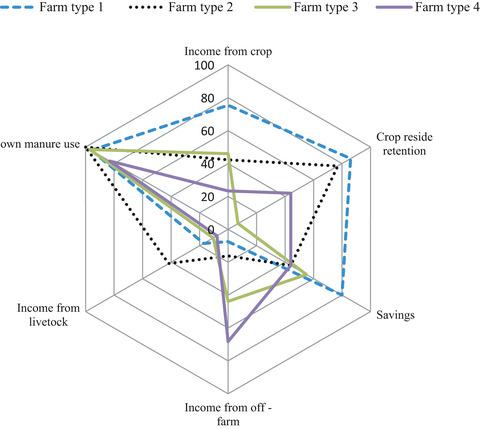当前位置:
X-MOL 学术
›
Food Energy Secur.
›
论文详情
Our official English website, www.x-mol.net, welcomes your feedback! (Note: you will need to create a separate account there.)
A farming system typology for the adoption of new technology in Bangladesh
Food and Energy Security ( IF 5 ) Pub Date : 2021-05-04 , DOI: 10.1002/fes3.287 Mamunur Rashid Sarker 1, 2 , Marcelo Valadares Galdos 1 , Andrew J. Challinor 1 , Akbar Hossain 3
Food and Energy Security ( IF 5 ) Pub Date : 2021-05-04 , DOI: 10.1002/fes3.287 Mamunur Rashid Sarker 1, 2 , Marcelo Valadares Galdos 1 , Andrew J. Challinor 1 , Akbar Hossain 3
Affiliation

|
Over the last three decades, few studies have been conducted to tackle the complexity and heterogeneity of Bangladesh farming systems. We address these research gaps with a new survey. Accordingly, a survey was conducted in North-Western Bangladesh to understand how socio-economic traits influence technology adoption and to identify and characterize key farm types. The survey was based on farm household characteristics, farm structure, farming practices and livestock as well as the economic performance of the farm. Principal component analysis (PCA) and cluster analysis (CA) were used to establish the different farm typologies, and the data set based on 27 variables was carefully analysed. The findings confirmed that the key variables that significantly affect the adoption of new agricultural technologies relate to age, farming experience, level of education of the household head, income, access to markets, land ownership, the proportion of hired labour, savings, food self-sufficiency and income from off-farm activities. Four main farm types were identified in the study area based on resource endowment and livelihood orientation. These are (1) well-resourced farmers entirely dependent on agriculture and less reliant on off-farm activities; (2) moderately resourced households, which are headed by an older male with greater farming experience and which are engaged in both on-farm and off-farm activities; (3) resource-constrained households with cattle as the main livestock and with income generated by the sale of livestock products; and (4) severely resource-constrained households which are headed by young farmers/men and where income is generated by off-farm activities. These four farm categories represent the heterogeneity of farms in North-West Bangladesh, and it is hoped that the development of this farm household typology will help particularly the extension service, to set up appropriate extension advice that will benefit the farming community.
中文翻译:

孟加拉国采用新技术的农业系统类型学
在过去的三十年里,很少有研究解决孟加拉国农业系统的复杂性和异质性。我们通过一项新调查解决了这些研究空白。因此,在孟加拉国西北部进行了一项调查,以了解社会经济特征如何影响技术采用,并确定和描述关键农场类型。该调查基于农户特征、农场结构、耕作方式和牲畜以及农场的经济表现。使用主成分分析 (PCA) 和聚类分析 (CA) 建立不同的农场类型,并对基于 27 个变量的数据集进行仔细分析。调查结果证实,显着影响采用新农业技术的关键变量与年龄、耕作经验、户主的教育水平、收入、市场准入、土地所有权、雇佣劳动力的比例、储蓄、粮食自给自足和非农活动收入。根据资源禀赋和生计导向,研究区确定了四种主要农场类型。它们是 (1) 资源充足的农民完全依赖农业,较少依赖非农活动;(2) 中等资源家庭,由具有更多耕作经验的年长男性当家并从事农场和非农场活动;(三)以牛为主要牲畜,有销售畜产品收入的资源受限家庭;(4) 以年轻农民/男性为户主的资源严重受限的家庭,其收入来自于非农活动。
更新日期:2021-05-04
中文翻译:

孟加拉国采用新技术的农业系统类型学
在过去的三十年里,很少有研究解决孟加拉国农业系统的复杂性和异质性。我们通过一项新调查解决了这些研究空白。因此,在孟加拉国西北部进行了一项调查,以了解社会经济特征如何影响技术采用,并确定和描述关键农场类型。该调查基于农户特征、农场结构、耕作方式和牲畜以及农场的经济表现。使用主成分分析 (PCA) 和聚类分析 (CA) 建立不同的农场类型,并对基于 27 个变量的数据集进行仔细分析。调查结果证实,显着影响采用新农业技术的关键变量与年龄、耕作经验、户主的教育水平、收入、市场准入、土地所有权、雇佣劳动力的比例、储蓄、粮食自给自足和非农活动收入。根据资源禀赋和生计导向,研究区确定了四种主要农场类型。它们是 (1) 资源充足的农民完全依赖农业,较少依赖非农活动;(2) 中等资源家庭,由具有更多耕作经验的年长男性当家并从事农场和非农场活动;(三)以牛为主要牲畜,有销售畜产品收入的资源受限家庭;(4) 以年轻农民/男性为户主的资源严重受限的家庭,其收入来自于非农活动。



























 京公网安备 11010802027423号
京公网安备 11010802027423号